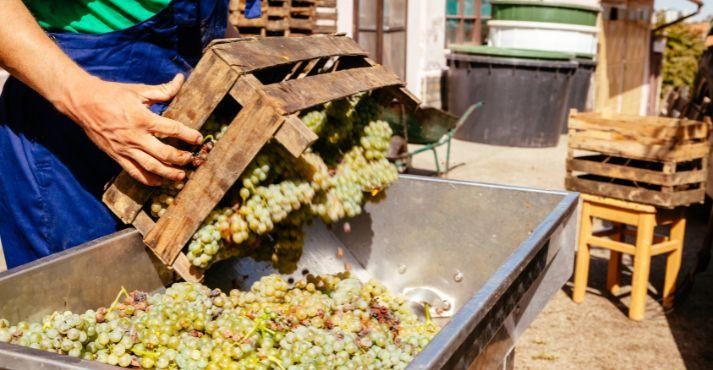Dry white wines are among the most popular choices in the culinary and wine worlds. They are valued for their crisp, refreshing taste and versatility. In the U.S. alone, white wines make up 48.5% of wine sales annually, with dry varieties being a top favorite.
Knowing what dry white wine is, is essential for anyone in hospitality, from chefs to sommeliers.
Also, knowing the differences helps in menu planning, enhances wine pairings, and allows for better guest recommendations, especially when choosing the best type of white wine for cooking.
What is Dry White Wine?
The term “dry” in wine refers to the residual sugar level or its absence. In simple wine terms, a dry white wine has little to no sweetness. This dryness is determined during fermentation, where yeast converts the natural sugars in grapes into alcohol.
For a wine to be considered “dry,” nearly all the sugar must be fully fermented, leaving less than 1% residual sugar.
This lack of sweetness gives dry wines their distinct crispness and refreshing taste. Dry white wines, like Sauvignon Blanc, Chardonnay, and Pinot Grigio, are known for their clean, bright flavors and high acidity.
These wines typically showcase notes of citrus, green apple, and sometimes herbaceous elements, making them versatile for wine-food pairings and cooking.
The dry profile is trendy in white wines for cooking, as the minimal sugar content adds to savory dishes without altering their flavor.
Knowing what makes a wine dry is important for selecting the right bottle, whether for enjoying on its own, pairing with a meal, or using recipes where a balanced, non-sweet wine is desired.
Dry vs. Sweet Wines
The key distinction between dry white and sweet wines is the residual sugar left after fermentation. During the winemaking process, yeast converts grape sugars into alcohol. In dry wines, this process continues until nearly all the sugar is fermented, leaving less than 1% residual sugar.
This minimal sweetness results in a crisp, clean taste. Common examples of dry white wines include Sauvignon Blanc, Pinot Grigio, and Chardonnay, known for their bright acidity and flavors like citrus, green apple, and herbs.
In contrast, sweet wines retain a higher residual sugar level after fermentation. The winemaker may stop the fermentation early, leaving more sugar in the wine, or use naturally sweeter grapes.
Sweet wines like Moscato, Riesling, and Sauternes are characterized by their rich, syrupy flavors, often including ripe peach, honey, and tropical fruits. These wines are typically enjoyed as dessert wines or paired with spicy dishes to balance the sweetness.
Comprehending the difference between dry white wines and sweet wines is essential, especially when selecting a wine for pairing or cooking.
For instance, options like Sauvignon Blanc or Chardonnay are preferred when looking for a dry wine to cook because their low sugar content and higher acidity develop the flavors of savory dishes without adding sweetness.
On the other hand, sweet wines are better suited for desserts or dishes where a touch of sweetness is desired.
Types of Dry White Wines
Dry white wines come in various styles with unique flavor profiles and characteristics. Let’s explore some of the most popular types of dry white wine varieties:

1. Sauvignon Blanc
Flavor profile: High acidity with lime, green apple, and fresh-cut grass flavors.
Known for its high acidity and herbaceous notes, Sauvignon Blanc is a classic dry white wine often associated with regions like New Zealand and the Loire Valley in France. It’s a versatile wine that pairs well with seafood and salads.
2. Chardonnay
Flavor profile: The flavor of this wine varies depending on its age. It can have citrus and green apple notes when unoaked or more decadent, buttery flavors when aged in oak.
One of the most widely planted grape varieties, Chardonnay can range from crisp and unoaked to rich and buttery. When aged in oak barrels, it often has a fuller body with notes of vanilla and toasted nuts. Chardonnay is a favorite among dry white wines for cooking, especially in creamy sauces.
3. Pinot Grigio
Flavor profile: Light-bodied with flavors of lemon, lime, and sometimes a hint of almond.
Light, crisp, and refreshing, Pinot Grigio is a popular dry white wine known for its clean, citrus flavors. It’s a go-to choice for those who enjoy a lighter, more straightforward wine, making it an excellent option for summer sipping.
4. Albarino
Flavor profile: Vibrant, with stone fruit flavors like peach and nectarine and a touch of salinity.
A lesser-known but fantastic dry white wine, Albarino hails from Spain and is prized for its bright acidity and notes of peach, lime, and salty wine minerality. It’s often enjoyed with shellfish and coastal dishes.
5. Gruner Veltliner
Flavor profile: Crisp, with flavors of white pepper, lime, and a subtle vegetal note.
Popular in Austria, Gruner Veltliner is a dry white wine with a unique peppery, herbal profile. It’s known for its versatility and pairs well with various foods, from spicy Asian dishes to grilled vegetables.
How Dry White Wine is Made?

Crafting dry white wine involves selecting specific grape varieties, precise harvesting, and precise fermentation techniques to achieve a dry profile with minimal residual sugar. Let’s break down the key steps in this process.
1. Grape Selection and Harvesting
The choice of grape variety is essential in determining the dryness of the final wine. Winemakers typically select grapes known for their high acidity and lower natural sugar levels, which contribute to a drier wine.
For example, Sauvignon Blanc grapes are often harvested early to preserve their bright acidity, resulting in a crisp, dry finish.
Cooler climate regions like New Zealand and the Loire Valley in France are ideal for growing such grape varieties, as the lower temperatures help maintain acidity and slow down sugar development.
This approach ensures the wine retains a zesty, refreshing character, a hallmark of many dry white wine types.
2. Fermentation Process
Fermentation is the critical stage where the wine’s dryness level is determined. During fermentation, yeast is added to the grape juice, converting the sugars into alcohol.
In the case of dry white wines, winemakers aim for a complete fermentation, where almost all of the sugar is fully converted. This process leaves less than 1% residual sugar, producing a clean, crisp wine profile.
The extended fermentation process sets dry wines apart from their sweeter counterparts. When allowing the yeast to ferment fully, winemakers create a wine with little to no sweetness but instead offer vibrant acidity and pure, nuanced flavors.
This style of wine is especially favored as a dry wine for cooking, as it boosts flavor in dishes without adding any sweet notes, making it ideal for savory recipes like sauces, marinades, and seafood dishes.
Tips for Choosing Quality Dry White Wines
Selecting the right dry white wine can make a significant difference, whether planning a wine tasting, creating a menu, or looking for the best white wine for cooking. Here are some tips for choosing high-quality options:
1. Check the Region
Certain regions are known for producing exceptional dry white wines. For example, the Loire Valley in France is famous for its Sauvignon Blanc, while Sonoma County in California is known for its Chardonnay.
2. Consider the Brand
Well-known brands often maintain consistent quality. Look for reputable names in dry white wines like Kim Crawford for Sauvignon Blanc or Kendall-Jackson for Chardonnay.
3. Know Your Preferences
If you prefer a crisp, light wine, go for a Pinot Grigio or Albarino. For a fuller-bodied experience, choose an oaked Chardonnay.
Frequently Asked Questions (FAQs)
Is Chardonnay dry white wine?
Chardonnay is typically a dry white wine, especially when it’s wholly fermented and aged without residual sugar. It can range from crisp and unoaked to rich and buttery when aged in oak barrels.
Is Pinot Grigio a dry white wine?
Yes, Pinot Grigio is considered a dry white wine. It’s known for its light body, bright acidity, and refreshing citrus flavors, making it a popular choice for summer drinking and food pairing.
Conclusion
Knowledge of dry white wine and its various types is essential for anyone interested in wine, whether for tasting, pairing, or cooking. Dry white wines, with their crisp flavors and balanced acidity, offer versatility and are a staple in the wine world.
From the famous Sauvignon Blanc and Chardonnay to unique varieties like Albarino and Gruner Veltliner, there’s a dry white wine for every palate and occasion.
When choosing the right dry white wine types, hospitality professionals can increase their offerings and provide memorable experiences for guests.
Accepting the diverse flavors and styles of dry white wines can elevate culinary creations, dining experiences, and wine-drinking practices.





























